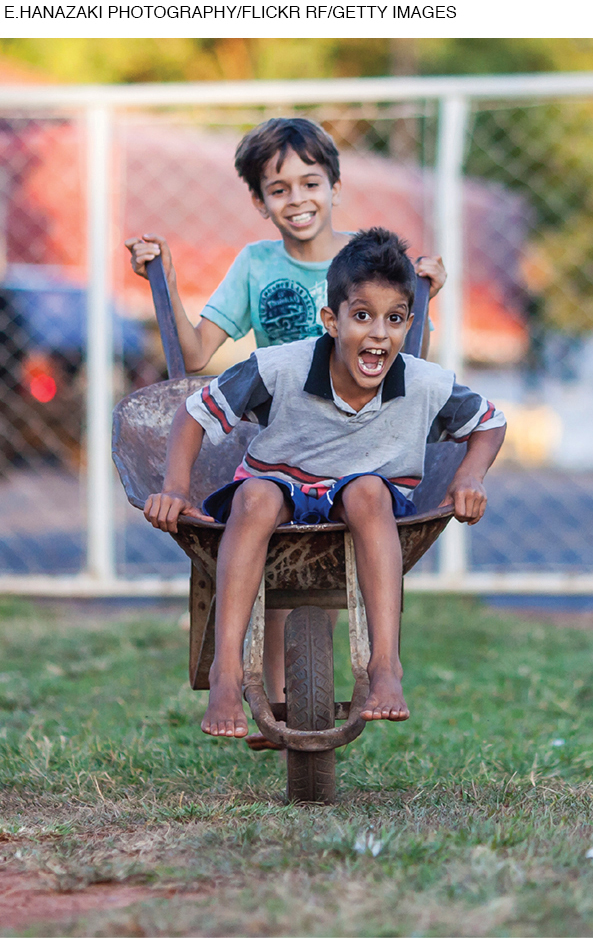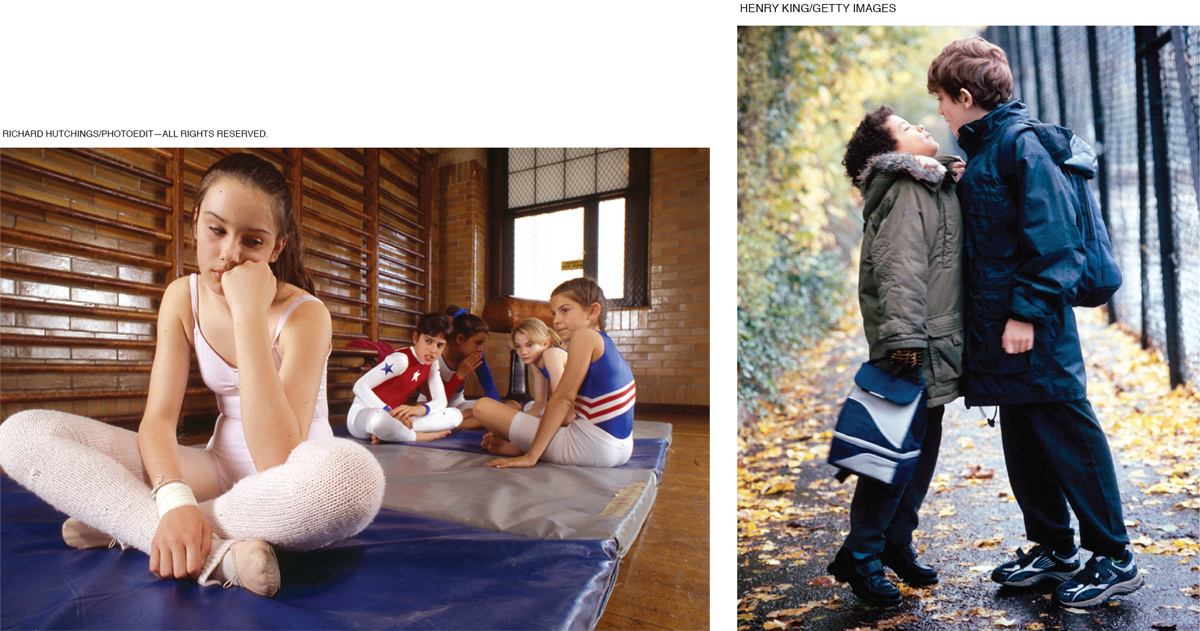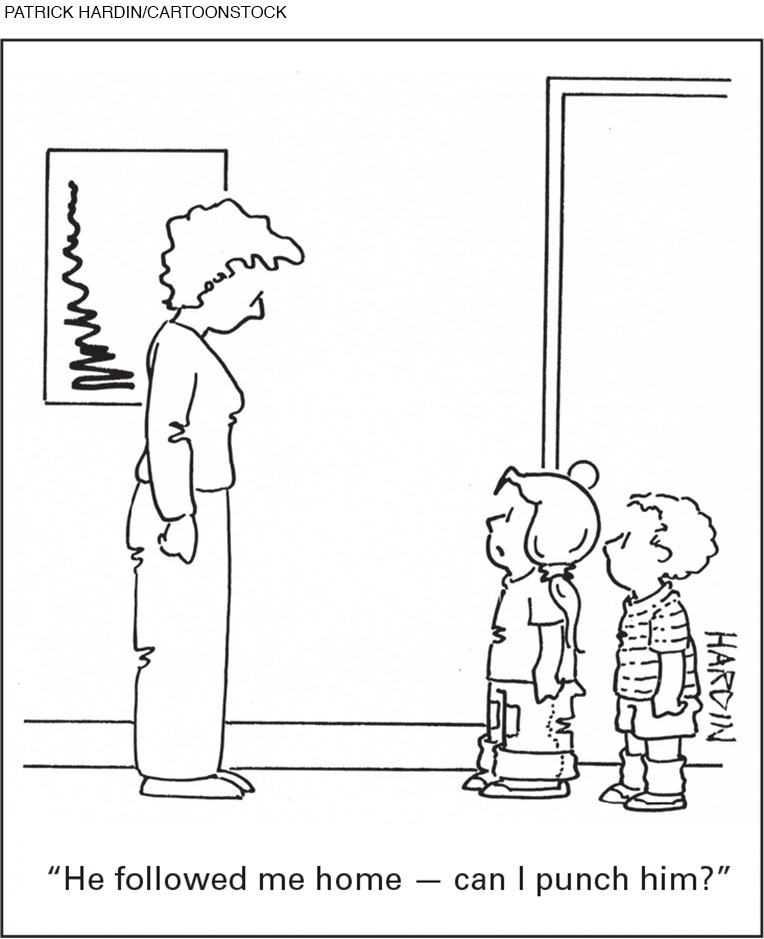The Peer Group
Peers become increasingly important in middle childhood. With their new awareness of reality (concrete operations), children are painfully aware of their classmates’ opinions, judgments, and accomplishments.
The Culture of Children

Children have customs, rules, and rituals that are passed down to younger children from slightly older ones. Jump-
Communication with peers is vital; children learn the accents and phrases that their friends use. Parents may proudly note how well their children speak a second language but may be distressed when their children spout their peers’ curses, accents, and slang.
Independence from adults is acclaimed. Peers pity those (especially boys) whose parents kiss them (“mama’s boy”), tease those who please the teachers (“teacher’s pet,” “suck-
Because they value independence, children find friends who defy authority, sometimes harmlessly (passing a note in class), sometimes not (shoplifting, smoking). If a bully teases or isolates a child, it is hard for the other children to defend the one who is shunned.

FRIENDSHIPS Teachers often try to separate friends, but developmentalists find that friends teach each other academic and social skills (Bagwell & Schmidt, 2011). Moreover, children learn faster and feel happier when they have friends. If they had to choose between being friendless but popular (looked up to by many peers) or having close friends but being unpopular (ignored by peers), most would choose to have friends (Bagwell & Schmidt, 2011). A wise choice.
301
Friendships become more intense and intimate over the years of middle childhood, as social cognition and effortful control advance. Six-
Older children tend to choose friends whose interests, values, and backgrounds are similar to their own. By the end of middle childhood, close friendships are almost always between children of the same sex, age, ethnicity, and socioeconomic status (Rubin et al., 2013). This occurs not because children naturally become more prejudiced in middle childhood (they do not) but because they seek friends who understand and agree with them.
THINK CRITICALLY: Do adults also choose friends who agree with them, or whose background is similar to their own?
Gender differences persist in activities (girls converse more whereas boys play more active games), but both boys and girls want best friends. Having no close friends at age 11 predicts depression at age 13 (Brendgen et al., 2010).
POPULAR AND UNPOPULAR CHILDREN The particular qualities that make a child liked or disliked depend on culture, cohort, and sometimes the local region or school. For example, shyness is not valued in North America, especially for boys in middle childhood, but this is not true everywhere.
Consider research on shy children in China. A 1990 survey in Shanghai found that shy children were liked and respected (X. Chen et al., 1992). Twelve years later, Chinese culture had shifted and a survey from the same schools found shy children less popular than their shy predecessors had been (X. Chen et al., 2005).
A few years later, a third study in rural China, far from Shanghai, found shyness still valued; it predicted adult adjustment (X. Chen et al., 2009). By contrast, a fourth study from a Chinese city found that shyness in middle childhood predicted unhappiness later on—
Other traits also vary in how much they are admired. At every age, children who are outgoing, friendly, and cooperative are well liked. In the United States, by the end of middle childhood, a second set of traits also predicts popularity: being dominant and somewhat aggressive (Shi & Xie, 2012).
aggressive-
A child who is not liked by peers and is antagonistic. Other children do not want to be friends with such a child because of his or her provocative, confrontational behavior.
withdrawn-
A child who avoids social interaction with peers. Other children do not want to be friends with such a child because of his or her timid, isolative, and anxious behavior.
There are three types of unpopular children. Some are neglected, not rejected; they are ignored, but not shunned. The other two types are actively rejected: aggressive-
Both aggressive-
302
bullying
Repeated, systematic efforts to inflict harm on other people through physical, verbal, or social attack on a weaker person.
Video: Bullying: Interview with Nicki Crick
BULLIES AND VICTIMS Bullying is defined as repeated, systematic attacks intended to harm those who are unable or unlikely to defend themselves. It occurs in every nation, in every community, and in every kind of school (religious or secular, public or private, progressive or traditional, large or small). Victims are chosen because they are powerless, with many possible characteristics.
As one boy explained:
You can get bullied because you are weak or annoying or because you are different. Kids with big ears get bullied. Dorks get bullied. You can also get bullied because you think too much of yourself and try to show off. Teacher’s pet gets bullied. If you say the right answer too many times in class you can get bullied. There are lots of popular groups who bully each other and other groups, but you can get bullied within your group, too. If you do not want to get bullied, you have to stay under the radar, but then you might feel sad because no one pays attention to you.
[quoted in Guerra et al., 2011, p. 306]
Bullying may be any of four types:
Physical (hitting, pinching, shoving, or kicking)
Verbal (teasing, taunting, or name-
calling) Relational (destroying peer acceptance)
Cyber (bullying that uses cell phones, computers, and other electronic devices)
The first three types are common in primary school and begin even earlier, in preschool. (Cyberbullying is more common later on, and it is discussed in Chapter 10.)
A key word in the definition of bullying is repeated. Almost every child experiences an isolated attack or is called a derogatory name at some point. Victims of bullying, however, endure shameful experiences again and again—

303
Although it is often thought that victims are chosen because their appearance or background is odd, this is not usually the case. Victims are chosen because of their emotional vulnerability and social isolation, not how they look. Children new to a school, or who do not know how to make friends, are especially vulnerable.
Remember the three types of unpopular children? Neglected children are not victimized; they are ignored, “under the radar.” If their family relationships are good, they suffer less even if they are bullied (which they usually are not) (Bowes et al., 2010).
bully-
Someone who attacks others and who is attacked as well. (Also called provocative victims because they do things that elicit bullying.)
Withdrawn-
Unlike bully-
Boy bullies usually physically attack smaller, weaker boys. Girl bullies usually use words to attack shyer, more soft-
CAUSES AND CONSEQUENCES OF BULLYING Bullying may originate with a genetic predisposition or a brain abnormality, but when a toddler is aggressive, parents, teachers, and peers usually teach emotional regulation and effortful control. If home life is stressful, if discipline is ineffectual, if siblings are hostile, or if attachment is insecure, those lessons may not be learned or even taught. Instead, some children develop externalizing and internalizing problems, becoming bullies or victims (Turner et al., 2012).
Peers are crucial. Some peer groups approve of relational bullying, and then children entertain their classmates by mocking and insulting each other (Werner & Hill, 2010). On the other hand, when students themselves disapprove, the incidence of bullying plummets (Guerra & Williams, 2010). Age matters. For most of childhood, bullies are disliked, but a switch occurs at about age 11, when bullying becomes a way to gain social status (Caravita & Cillessen, 2012).
The consequences of bullying can echo for years, worsening with age. Many victims become depressed; many bullies become increasingly cruel. The worst bullies seem unmoved by their victims’ distress: Such bullies become more aggressive with age (Willoughby et al., 2014).
THINK CRITICALLY: The text says both former bullies and former victims suffer in adulthood. Which would you rather be, and why?
Unless bullies are deterred, they and their victims risk impaired social understanding, lower school achievement, and relationship difficulties. Decades later they have higher rates of mental illness (Copeland et al., 2013; Ttofi et al., 2014). Compared to other adults the same age, former bullies are more likely to die young, be jailed, or have destructive marriages.
CAN BULLYING BE STOPPED? Most victimized children find ways to halt ongoing bullying—
304

We know what does not work: simply increasing students’ awareness of bullying, instituting zero tolerance for fighting, or putting bullies together in a therapy group or a classroom (Baldry & Farrington, 2007; Monks & Coyne, 2011). This last measure tends to make daily life easier for some teachers, but it increases aggression.
Another strategy is to talk to the parents of the bully, but this may backfire. Since one cause of bullying is poor parent–
The school community as a whole—
Again, peers are crucial: They must do more than simply becoming aware, as some naive adults believe. In fact, some bystanders notice and then disengage from the victims, which increases bullying. Others are sympathetic but feel powerless (Thornberg & Jungert, 2013). However, if children are helped to empathize with victims, feel effective (high in effortful control), and refuse to admire bullies, then classroom aggression is reduced (Salmivalli, 2010).
Efforts to change the entire school are credited with recent successful attempts to decrease bullying in 29 schools in England (Cross et al., 2011), throughout Norway, in Finland (Kärnä et al., 2011), and often in the United States (Allen, 2010; Limber, 2011).
A review of ways to halt bullying (Berger, 2007) finds:
Everyone in the school must change, not just the identified bullies.
Intervention is more effective in the earlier grades.
Evaluation is critical: Programs that seem good might be harmful.
This final point merits emphasis. Longitudinal research on whole-
Objective follow-
WHAT HAVE YOU LEARNED?
Question 8.20
1. How does what children wear reflect the culture of children?
The particular habits, styles, and values of a specific cohort affect the set of rules and rituals that characterize children as distinct from adults.
Question 8.21
2. In what ways do friendships change from the beginning to the end of middle childhood?
Friendships become more intense and intimate as social cognition and effortful control advance throughout childhood. Six-
Question 8.22
3. How is a child’s popularity affected by culture and cohort?
Culture determines which qualities are desirable to other children; for example, shy children are popular in Shanghai but unpopular in North America. Cohort matters, too; that shy child in 1990 Shanghai who was popular would not be as popular in 2005 Shanghai, as Chinese culture has changed over time and come to value assertiveness more.
Question 8.23
4. What changes in the criteria for popularity as children mature from early childhood to adolescence?
At every age, children who are outgoing, friendly, and cooperative are well liked. But by middle childhood, being dominant and somewhat aggressive also predicts popularity.
Question 8.24
5. What are the different kinds of bullying?
Four types of bullying are discussed in the text: (1) physical—
Question 8.25
6. How do boy bullies differ from girl bullies?
Boy bullies are usually physically bigger than their victims, and they rely on physical aggression toward smaller, weaker boys. Girl bullies tend to rely on verbal or relational aggression toward shyer, more soft-
Question 8.26
7. What school characteristics make bullying more likely?
Research indicates that measures such as simply increasing students’ awareness of bullying, instituting zero tolerance for fighting, or putting bullies together in a therapy group or classroom are ineffective. Talking to the parents of the bully may also do more harm than good.
Question 8.27
8. How might bullying be reduced?
Teaching empathy through cooperative learning, encouraging friendship and school pride, and implementing a “whole school” approach seem to be most effective. Telling peers what to do if they witness bullying and to be empathetic to the victim rather than reinforce (approve of) the bully’s behavior also helps.